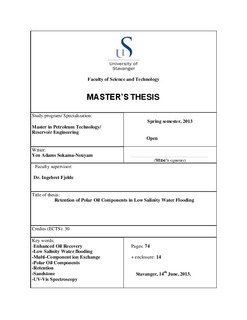| dc.contributor.author | Sokama-Neuyam, Yen Adams | |
| dc.date.accessioned | 2013-11-13T16:51:45Z | |
| dc.date.available | 2013-11-13T16:51:45Z | |
| dc.date.issued | 2013-06-14 | |
| dc.identifier.uri | http://hdl.handle.net/11250/183555 | |
| dc.description | Master's thesis in Petroleum engineering | no_NO |
| dc.description.abstract | The influence of brine chemistry, salinity and composition on the retention of polar oil components onto reservoir rock mineral surface in relation to low salinity water flooding (LSWF) was studied and evaluated in this piece of work using ultra-violet visible (UV-Vis) spectroscopy. Five different brine compositions; sea water (SW), formation water (FW), LSW1 (FW diluted 100 times), LSW2 (FW diluted 1000 times) and KCl low salinity brine were studied and their effect on the retention of polar oil components was evaluated. Research was further extended to investigate the effect of the amount of acidic components in crude oil on the retention of polar oil components in LSWF. Two sets of diluted crude oil samples were investigated and evaluated; untreated stock tank oil (STO) and treated STO (Crude oil containing reduced amount of acidic components). Initial experiments were conducted to prepare a standard absorption curve and flooding experiments were carried out to study the retention of polar oil components. This thesis also evaluated the importance of the results obtained to field application.
It was observed in this work that the retention of polar oil components is a strong function of brine salinity and chemistry. The retention of polar oil components was highest when the reservoir rock in equilibrium with low salinity water (LSW1 and LSW2) was flooded with diluted STO. Earlier works stated that LSW1 and LSW2 contain higher total concentration of divalent cations onto the reservoir mineral surface than SW and FW. High total concentration of divalent cations onto reservoir rock minerals enables more polar components to be bonded onto the mineral surface through cation bridging. Also, generally, SW reported lower retention of polar oil components onto the reservoir rock surface compared to FW. SW contains less amount of Ca2+ than FW. In cation exchange, Ca2+ is given high replacing preference than other divalent cations such as Mg2+ which implies that Ca2+ plays a more significant role in cation bridging than Mg2+ which could also be the reason for the increased retention observed with FW than SW. KCl low salinity brine reported the lowest retention of polar oil components.
Two brine compositions (FW and KCl brine) were set up to investigate the effect of the amount of acidic components present in STO on retention of polar oil components. STO was treated with potassium silicate (Si2O:K2O) to reduce acidic components present. Results obtained indicated that retention of polar oil components was sensitive to the amount of acidic components present in STO. Retention of polar oil components was higher when the column was flooded with STO containing reduced amount of acidic components. It has been reported in literature that an increase in base/acid ratio of STO decreases the stabilization of the water-film on the mineral surface due to increased attractive forces. The treated STO has high base/acid ratio due to the reduction of the amount of acidic components it contains. KCl brine reported the lowest retention of polar oil components because it contains no divalent cations to bond polar oil components onto the rock surface through multi-components ion exchange (MIE) and cation bridging.
This work is very useful for evaluating the low salinity effect of crude oils and reservoir rocks. It provides a simple, cheaper but effective technique of selecting the optimum salinity and composition of brine required to give good results in LSWF.
It was observed that there is retention of polar oil components during the flooding experiments. The retention of polar oil components was dependent on the composition of brine in equilibrium with the reservoir rock column. The amount of acidic components present in STO also affects the retention of polar oil components onto reservoir rock minerals. STO with reduced amount of acidic components reported higher retention of polar oil components compared to untreated STO.
Estimating retention with UV-Vis spectroscopy within 400nm wavelength could not detect all the polar components present. It is therefore recommended that further work should be carried out to measure retention within other ranges of wavelength. Also UV-Vis Spectroscopy do not give specific measurement of retention but it is only able to compare the amount of polar components in two samples. There is therefore the need to seek improvement by adopting methods capable of estimating retention of polar components more specifically. | no_NO |
| dc.language.iso | eng | no_NO |
| dc.publisher | University of Stavanger, Norway | no_NO |
| dc.relation.ispartofseries | Masteroppgave/UIS-TN-IPT/2013; | |
| dc.subject | enhanced oil recovery | no_NO |
| dc.subject | low salinity water flooding | no_NO |
| dc.subject | polar oil components | no_NO |
| dc.subject | UV-Vis spectroscopy | no_NO |
| dc.subject | petroleumsteknologi | no_NO |
| dc.subject | EOR | no_NO |
| dc.subject | reservoarteknologi | no_NO |
| dc.title | Retention of polar oil components in low salinity water flooding | no_NO |
| dc.type | Master thesis | no_NO |
| dc.subject.nsi | VDP::Technology: 500::Rock and petroleum disciplines: 510::Petroleum engineering: 512 | no_NO |
